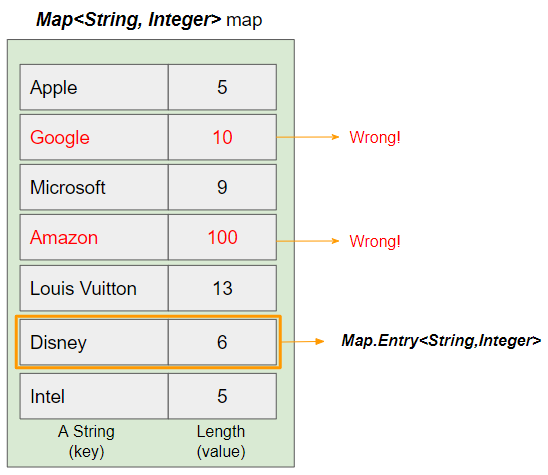Hướng dẫn và ví dụ Java BiPredicate
1. BiPredicate
Trong Java 8, BiPredicate là một functional interface, đại diện cho một toán tử chấp nhận hai tham số đầu vào và trả về một giá trị boolean.
BiPredicate interface
@FunctionalInterface
public interface BiPredicate<T, U> {
boolean test(T t, U u);
default BiPredicate<T, U> and(BiPredicate<? super T, ? super U> other) {
Objects.requireNonNull(other);
return (T t, U u) -> test(t, u) && other.test(t, u);
}
default BiPredicate<T, U> negate() {
return (T t, U u) -> !test(t, u);
}
default BiPredicate<T, U> or(BiPredicate<? super T, ? super U> other) {
Objects.requireNonNull(other);
return (T t, U u) -> test(t, u) || other.test(t, u);
}
}Xem thêm: Predicate là một functional interrface tương tự BiPredicate, nhưng nó chỉ chấp nhận một tham số:
Ví dụ: Tạo một đối tượng BiPredicate để kiểm tra độ dài của một String có khớp với một số được cung cấp hay không.
BiPredicateEx1.java
package org.o7planning.bipredicate.ex;
import java.util.function.BiPredicate;
public class BiPredicateEx1 {
public static void main(String[] args) {
// Create a BiPredicate.
BiPredicate<String,Integer> tester = (aString, aNumber) -> {
return aString.length() == aNumber;
};
// Test:
boolean testResult = tester.test("o7planning.org", 14);
System.out.println("Test Result: " + testResult);
}
}Output:
Test Result: trueTiếp tục với ví dụ trên. Một đối tượng Map<String,Integer> chứa các ánh xạ giữa một String và độ dài của nó, tuy nhiên có một vài ánh xạ không chính xác. Hãy in ra các ánh xạ chính xác.

BiPredicateEx2.java
package org.o7planning.bipredicate.ex;
import java.util.HashMap;
import java.util.Map;
import java.util.function.BiPredicate;
public class BiPredicateEx2 {
public static void main(String[] args) {
// Create a BiPredicate.
BiPredicate<String,Integer> tester = (aString, aNumber) -> {
return aString.length() == aNumber;
};
// String aString --> Integer length.
Map<String,Integer> map = new HashMap<String,Integer>();
map.put("Apple", 5);
map.put("Google", 10); // Wrong
map.put("Microsoft", 9);
map.put("Amazon", 100); // Wrong
map.put("Louis Vuitton", 13);
map.put("Disney", 6);
map.put("Intel", 5);
map.entrySet() // Set<Map.Entry<String,Integer>>
.stream() // Stream<Map.Entry<String,Integer>>
// filter(Predicate<Map.Entry<String,Integer>>)
.filter(entry -> tester.test(entry.getKey(), entry.getValue())) // Stream<Map.Entry<String,Integer>>
.forEach(entry -> System.out.println(entry.getKey() +" --> " + entry.getValue()));
}
}Output:
Apple --> 5
Disney --> 6
Louis Vuitton --> 13
Microsoft --> 9
Intel --> 53. BiPredicate + Method reference
Nếu một phương thức tĩnh có 2 tham số và trả về kiểu boolean thì tham chiếu của nó được coi là một BiPredicate:
Ví dụ:
BiPredicate_mRef_ex1.java
package org.o7planning.bipredicate.ex;
import java.util.function.BiPredicate;
public class BiPredicate_mRef_ex1 {
public static void main(String[] args) {
// Create a BiPredicate from a Method reference.
BiPredicate<Staff,Integer> tester = StaffUtils::higher;
Staff tom = new Staff("Tom", 3000);
boolean testResult = tester.test(tom, 2000);
System.out.println("Test Result: " + testResult);
}
}
class StaffUtils {
// A static method take 2 input parameters and return boolean type.
public static boolean higher(Staff staff, int salary) {
return staff.getSalary() > salary;
}
}
class Staff {
private String fullName;
private int salary;
public Staff(String fullName, int salary) {
this.fullName = fullName;
this.salary = salary;
}
public String getFullName() {
return fullName;
}
public int getSalary() {
return salary;
}
}Output:
Test Result: true4. negate()
Phương thức negate() trả về một đối tượng BiPredicate mới mà kết quả đánh giá của nó là phủ định của BiPredicate hiện tại.
default BiPredicate<T, U> negate() {
return (T t, U u) -> !test(t, u);
}Ví dụ: Một BiPredicate<Integer,Integer> để kiểm tra 2 số để xem số thứ nhất lớn hơn số thứ hai hay không.
BiPredicate_negate_ex1.java
package org.o7planning.bipredicate.ex;
import java.util.function.BiPredicate;
public class BiPredicate_negate_ex1 {
public static void main(String[] args) {
// Create a BiPredicate.
// Check if anInteger1 > anInteger2
BiPredicate<Integer, Integer> tester = (anInteger1, anInteger2) -> {
return anInteger1 > anInteger2;
};
boolean test1 = tester.test(100, 10);
boolean test2 = tester.negate().test(100, 10);
System.out.println("Test1: " + test1);
System.out.println("Test2: " + test2);
}
}Output:
Test1: true
Test2: falseVí dụ: Một đối tượng Map<String,Integer> chứa các ánh xạ giữa một String và độ dài của nó, tuy nhiên có một vài ánh xạ không chính xác. Hãy in ra các ánh xạ không chính xác đó.
BiPredicate_negate_ex2.java
package org.o7planning.bipredicate.ex;
import java.util.HashMap;
import java.util.Map;
import java.util.function.BiPredicate;
public class BiPredicate_negate_ex2 {
public static void main(String[] args) {
// Create a BiPredicate.
// Check if length of a String equals to aNumber.
BiPredicate<String,Integer> tester = (aString, aNumber) -> {
return aString.length() == aNumber;
};
// String aString --> Integer length.
Map<String,Integer> map = new HashMap<String,Integer>();
map.put("Apple", 5);
map.put("Google", 10); // Wrong
map.put("Microsoft", 9);
map.put("Amazon", 100); // Wrong
map.put("Louis Vuitton", 13);
map.put("Disney", 6);
map.put("Intel", 5);
map.entrySet() // Set<Map.Entry<String,Integer>>
.stream() // Stream<Map.Entry<String,Integer>>
// filter(Predicate<Map.Entry<String,Integer>>)
.filter(entry -> tester.negate().test(entry.getKey(), entry.getValue())) // Stream<Map.Entry<String,Integer>>
.forEach(entry -> System.out.println(entry.getKey() +" --> " + entry.getValue()));
}
}Output:
Google --> 10
Amazon --> 1005. and(BiPredicate other)
Phương thức and(other) tạo ra một đối tượng BiPredicate mới từ việc kết hợp đối tượng BiPredicate hiện tại và other, nó được đánh giá là true nếu cả hai BiPredicate hiện tại và other được đánh giá là true.
default BiPredicate<T, U> and(BiPredicate<? super T, ? super U> other) {
Objects.requireNonNull(other);
return (T t, U u) -> test(t, u) && other.test(t, u);
}Ví dụ:
BiPredicate_and_ex1.java
package org.o7planning.bipredicate.ex;
import java.util.function.BiPredicate;
public class BiPredicate_and_ex1 {
public static void main(String[] args) {
// Test if anInteger1 > anInteger2
BiPredicate<Integer, Integer> tester1 = (anInteger1, anInteger2) -> {
return anInteger1 > anInteger2;
};
// Test if anInteger1 + anInteger2 > 100
BiPredicate<Integer, Integer> tester2 = (anInteger1, anInteger2) -> {
return anInteger1 + anInteger2 > 100;
};
// Test if number1 > number2 and number1 + number2 > 100.
boolean testResult1 = tester1.and(tester2).test(70, 45);
boolean testResult2 = tester1.and(tester2).test(45, 70);
System.out.println("Test Result 1: " + testResult1);
System.out.println("Test Result 2: " + testResult2);
}
}Output:
Test Result 1: true
Test Result 2: false6. or(BiPredicate other)
Phương thức or(other) trả về một đối tượng BiPredicate mới từ việc kết hợp đối tượng BiPredicate hiện tại và other, nó được đánh giá là true nếu một trong hai, BiPredicate hiện tại hoặc other được đánh giá là true.
default BiPredicate<T, U> or(BiPredicate<? super T, ? super U> other) {
Objects.requireNonNull(other);
return (T t, U u) -> test(t, u) || other.test(t, u);
}Ví dụ:
BiPredicate_or_ex1.java
package org.o7planning.bipredicate.ex;
import java.util.function.BiPredicate;
public class BiPredicate_or_ex1 {
public static void main(String[] args) {
// Test if anInteger1 > anInteger2
BiPredicate<Integer, Integer> tester1 = (anInteger1, anInteger2) -> {
return anInteger1 > anInteger2;
};
// Test if anInteger1 + anInteger2 > 100
BiPredicate<Integer, Integer> tester2 = (anInteger1, anInteger2) -> {
return anInteger1 + anInteger2 > 100;
};
// Test if number1 > number2 or number1 + number2 > 100.
boolean testResult1 = tester1.or(tester2).test(70, 45);
boolean testResult2 = tester1.or(tester2).test(45, 70);
System.out.println("Test Result 1: " + testResult1);
System.out.println("Test Result 2: " + testResult2);
}
}Output:
Test Result 1: true
Test Result 2: trueJava cơ bản
- Tùy biến trình biên dịch java xử lý Annotation của bạn (Annotation Processing Tool)
- Lập trình Java theo nhóm sử dụng Eclipse và SVN
- Hướng dẫn và ví dụ Java WeakReference
- Hướng dẫn và ví dụ Java PhantomReference
- Hướng dẫn nén và giải nén trong Java
- Cấu hình Eclipse để sử dụng JDK thay vì JRE
- Phương thức String.format() và printf() trong Java
- Cú pháp và các tính năng mới trong Java 5
- Cú pháp và các tính năng mới trong Java 8
- Hướng dẫn sử dụng biểu thức chính quy trong Java
- Hướng dẫn lập trình đa luồng trong Java - Java Multithreading
- Thư viện điều khiển các loại cơ sở dữ liệu khác nhau trong Java
- Hướng dẫn sử dụng Java JDBC kết nối cơ sở dữ liệu
- Lấy các giá trị của các cột tự động tăng khi Insert một bản ghi sử dụng JDBC
- Hướng dẫn và ví dụ Java Stream
- Functional Interface trong Java
- Giới thiệu về Raspberry Pi
- Hướng dẫn và ví dụ Java Predicate
- Abstract class và Interface trong Java
- Access modifier trong Java
- Hướng dẫn và ví dụ Java Enum
- Hướng dẫn và ví dụ Java Annotation
- So sánh và sắp xếp trong Java
- Hướng dẫn và ví dụ Java String, StringBuffer và StringBuilder
- Hướng dẫn xử lý ngoại lệ trong Java - Java Exception Handling
- Hướng dẫn và ví dụ Java Generics
- Thao tác với tập tin và thư mục trong Java
- Hướng dẫn và ví dụ Java BiPredicate
- Hướng dẫn và ví dụ Java Consumer
- Hướng dẫn và ví dụ Java BiConsumer
- Bắt đầu với Java cần những gì?
- Lịch sử của Java và sự khác biệt giữa Oracle JDK và OpenJDK
- Cài đặt Java trên Windows
- Cài đặt Java trên Ubuntu
- Cài đặt OpenJDK trên Ubuntu
- Cài đặt Eclipse
- Cài đặt Eclipse trên Ubuntu
- Học nhanh Java cho người mới bắt đầu
- Lịch sử của bit và byte trong khoa học máy tính
- Các kiểu dữ liệu trong Java
- Các toán tử Bitwise
- Câu lệnh rẽ nhánh (if else) trong Java
- Câu lệnh rẽ nhánh switch trong Java
- Vòng lặp trong Java
- Mảng (Array) trong Java
- JDK Javadoc định dạng CHM
- Thừa kế và đa hình trong Java
- Hướng dẫn và ví dụ Java Function
- Hướng dẫn và ví dụ Java BiFunction
- Ví dụ về Java encoding và decoding sử dụng Apache Base64
- Hướng dẫn và ví dụ Java Reflection
- Hướng dẫn gọi phương thức từ xa với Java RMI
- Hướng dẫn lập trình Java Socket
- Các nền tảng nào bạn nên chọn để lập trình ứng dụng Java Desktop?
- Hướng dẫn và ví dụ Java Commons IO
- Hướng dẫn và ví dụ Java Commons Email
- Hướng dẫn và ví dụ Java Commons Logging
- Tìm hiểu về Java System.identityHashCode, Object.hashCode và Object.equals
- Hướng dẫn và ví dụ Java SoftReference
- Hướng dẫn và ví dụ Java Supplier
- Lập trình Java hướng khía cạnh với AspectJ (AOP)
Show More
- Hướng dẫn lập trình Java Servlet/JSP
- Các hướng dẫn Java Collections Framework
- Java API cho HTML & XML
- Các hướng dẫn Java IO
- Các hướng dẫn Java Date Time
- Các hướng dẫn Spring Boot
- Các hướng dẫn Maven
- Các hướng dẫn Gradle
- Các hướng dẫn Java Web Services
- Các hướng dẫn lập trình Java SWT
- Các hướng dẫn lập trình JavaFX
- Các hướng dẫn Java Oracle ADF
- Các hướng dẫn Struts2 Framework
- Các hướng dẫn Spring Cloud
